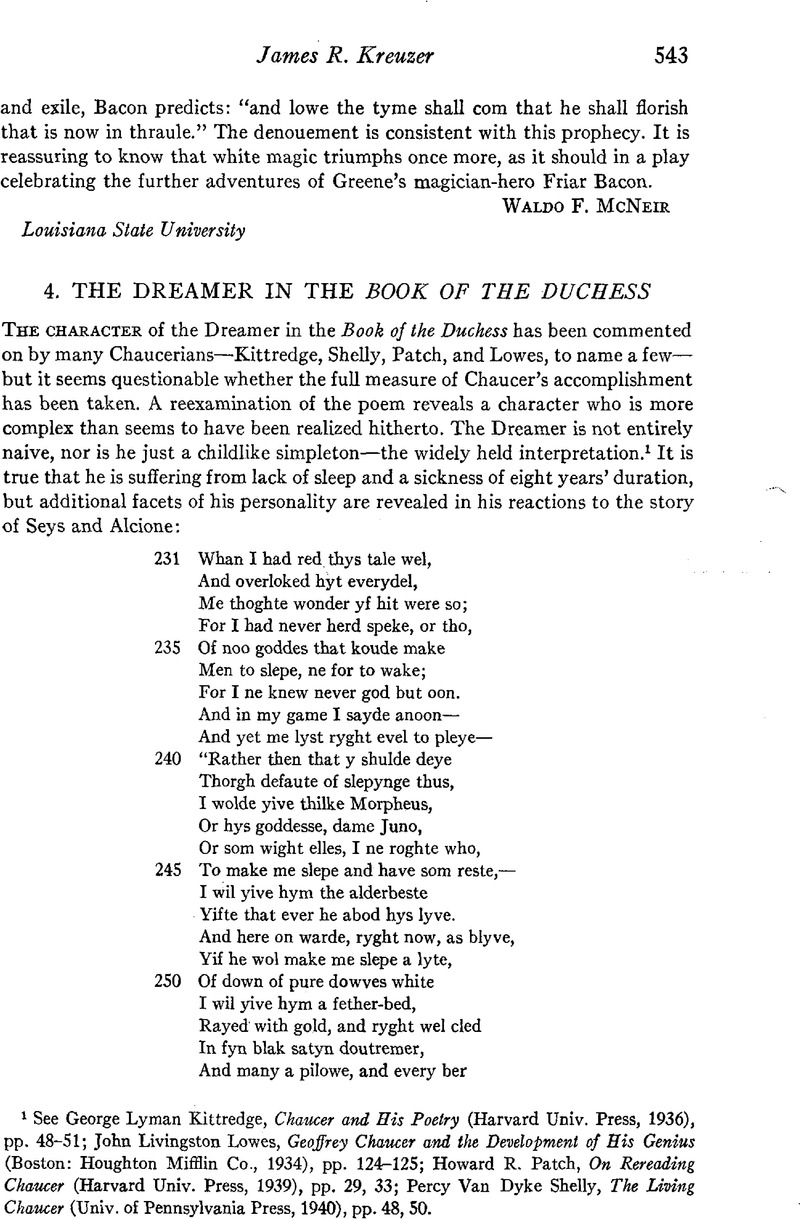Article contents
The Dreamer in the Book of the Duchess
Published online by Cambridge University Press: 02 December 2020
Abstract

- Type
- Comment and Criticism
- Information
- Copyright
- Copyright © Modern Language Association of America, 1951
References
Note 1 in page 543 See George Lyman Kittredge, Chaucer and Bis Poetry (Harvard Univ. Press, 1936), pp. 48–51; John Livingston Lowes, Geoffrey Chaucer and the Development of Bis Genius (Boston: Houghton Mifflin Co., 1934), pp. 124–125; Howard R. Patch, On Rereading Chaucer (Harvard Univ. Press, 1939), pp. 29, 33; Percy Van Dyke Shelly, The Living Chaucer (Univ. of Pennsylvania Press, 1940), pp. 48, 50.
Note 2 in page 544 Quotations from the Book of the Duchess are from The Complete Works of Geoffrey Chaucer, ed. Fred N. Robinson (Cambridge: Houghton Mifflin Co., 1933).
Note 8 in page 546 This interpretation is supported by Wolfgang Cièmen, Der Junge Chaucer (Bochum-Langendreer: Verlag Heinrich Poppinghaus O. H.-G., 1938): “Denn dass der Dichter dieses sein Nichtverstehen auch vom Leser als etwas Absichtliches und ‘Gespieltes’ aufge-fasst wissen wollte, geht aus den Versen 477–479 hervor, in denen ja der Ritter in der ‘Complainte,‘ die vom Dichter bewusst mitangehort und wiederberichtet wird, den Tod seiner Geliebtenausspricht” (p. 58).
Note 4 in page 547 Cièmen points out that the use of a real character—the Black Knight as John of Gaunt —instead of an allegorical abstraction shows a considerable development in Chaucer's handling of the dream-vision form in comparison to Machaut, for example. He says: “So hat Chaucer im ‘Buch der Herzogin’ einen ersten Schritt vom allegorischen Dialog, vom beziehungslosen Gegenuberstehen râsonnierender Schemen zum Gesprâch zwischen Menschen getan. Dass er bei dem Traumgespràch im ‘Buch der Herzogin’ an einen be-stimmten Menschen, den Herzog von Gaunt, dachte, hat seine ganze Gestaltungsweise beeinflusst. In das allegorische Traumgedicht ist damit eine neue Dimension hineingekom-men, wenn auch erst in einer unfertigen, angedeuteten Weise” (p. 66).
Note 5 in page 547 “Three Chaucer Notes,” Essays and Studies in Honor of Carleton Brown (New York Univ. Press, 1940), pp. 95–97.
Note 6 in page 547 F. J. Furnivall, Trial Forewords (London: Chaucer Society, 1871), p. 115.
- 1
- Cited by


